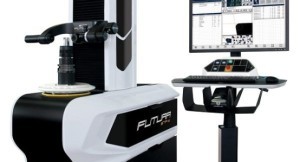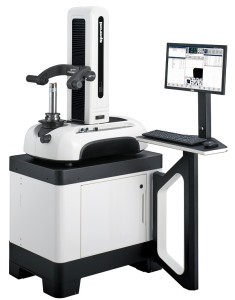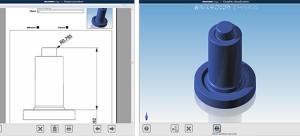In-Machine Tool Measurement vs. Offline Presetting
-
Offline presetting minimizes tool adjustment and setup time, keeping the machine in production and enhancing efficiency.
-
Offline presetters offer higher precision in measuring tools compared to in-machine methods, ensuring better part quality and reducing waste.
-
Using offline presetters allows for more effective use of multiple machines without requiring additional expensive equipment, leading to better cost management and productivity.
In-machine laser technology is touted by machine tool builders and distributors as the way of the future and an indispensable tool for machinists. Do you really need an offline presetter if you have in-machine lasers? Yes, you do, and here’s why.
In-machine tool measurement has become a standard feature on many of today’s metalworking machines that use lasers to measure key setup parameters. This enables the machine to diagnose and, in some cases, automatically adjust the cutting tool to correct for cutter or spindle runout. This type of in-machine laser technology is being touted by machine tool builders and distributors as the way of the future and an indispensable tool for machinists. So now, needless to say perhaps, I’m being asked all of the time, “Do I really need an offline presetter if I have in-machine lasers?” And my answer is very often a resounding “Yes!” Here’s why:
Presetters provide extremely valuable supplemental setup capabilities that in-machine functionalities cannot. This is particularly true in high stakes, high precision applications; in large capacity shops that operate, for example, 20 to 100 machining centers; and even in small “mom-and-pop” shops that have to maximize output from just one or two spindles. So as we compare and contrast the capabilities of in-machine tool measurement with those of offline or standalone presetters, the hope is that we might alter the way most folks think about the entire Laser vs. Preset debate. In the end, it’s less about choosing which one system is “best” and more about discovering the many benefits of using both systems in conjunction.
KEY FACTS ABOUT OFFLINE PRESETTERS VS. IN-MACHINE LASER TOOLS
In addition to the ways listed nearby that these two types of systems may help complement one another and overcome known shortfalls, there are also critical factors that help illustrate the value of offline presetters working alone and particularly in complement with laser technologies to improve manufacturing efficiency, save costs, and maximize profit (see Chart 1).
Adjustment & Cutting Time: Adjustments that could take up to 15 minutes when made in-machine can be made offline in less than one minute using a presetter, with your machine cutting – and earning revenue – that entire time. But reduced tool-changeover time isn’t the only time saver . . . in fact, one aerospace customer of ours recently reported how having offline presetters actually makes their in-machine lasers measure faster. By measuring their tools offline first, key setup data can be pre-loaded into the machine’s tool table via RFID. From there the laser acts as a final check before starting production.
But here’s the difference, and it’s a great example of how presetter and in-machine technologies work together for optimal manufacturing results: Because the preset lengths were already loaded into the machine’s tool table, the cutting tool will travel rapidly in approach speed only until it contacts the laser, effectively marking the final check and the beginning of production. If no preset values were in the tool table, however, that same cutter would move slowly and in repeated approach until it contacts the laser three to five times. So by combining offline and in-machine measurements, the client is now calibrating tools in a fraction of the time, making more chips, and using fewer machine passes with both technologies than would otherwise be possible by using only one.
Ease of Use: Operators can preset offline tools in preparation for the next job or reset tools after changing inserts while the machine continues to run, instead of wasting valuable spindle time touching off tooling or making trial cuts.
Accuracy: Presetters are simply better at measuring than machine tools, which often fail to measure and store real values for runout and/or length. This, coupled with expected inaccuracies resulting from laser refraction off of diamond- and other impregnated cutting tools, and many scenarios can arise with in-machine measuring tools that will still require test cuts, “wasted” machine time, and scrap parts. As such, it’s only when adding in the precision and functional advantages brought on by an offline presetter that machinists improve their ability to produce a good part on the first try, saving time in the process and reducing consumables costs as well.
Equipment Cost: It’s yet another popular misconception that in-machine lasers are standard or included options that come with machine tools straight from the factory. Closer investigation will reveal that you’re still buying the lasers, typically at a cost of around $13,000 per machine. So when you look at the variety of presetters that are available today, cost-effective options may be available that can be used to better monetize and more efficiently operate not just one, but multiple machine centers shop-wide.
Return on Investment (ROI): The best answer to the infamous question “How can we make more chips?” is really a simple one. It’s by doing more set-up operations outside of the machine while the spindle is still running and earning you revenue! By setting up tools outside the machine, a shop can increase production without purchasing another machining center that can cost hundreds of thousands of dollars and ultimately won’t increase production any more than what could be accomplished at a fraction of the cost by investing in one or more presetters. Most of our customers report that their presetter pays for itself within 30 days of implementation, which is a degree of return on investment that you simply won’t achieve when opting for in-machine technology alone!
Here’s the bottom line: I’ve said openly before that if you absolutely have to pick only one, I would definitely recommend going with an offline presetter(s) every time. But for customers who are apt to use both lasers and presetters – and we’re seeing more and more customers go this route – the cooperation between the two systems just makes for superior manufacturing when compared to what often results when using one over the other.
Did you find this interesting or helpful? Let us know what you think by adding your comments or questions below.





Add new comment